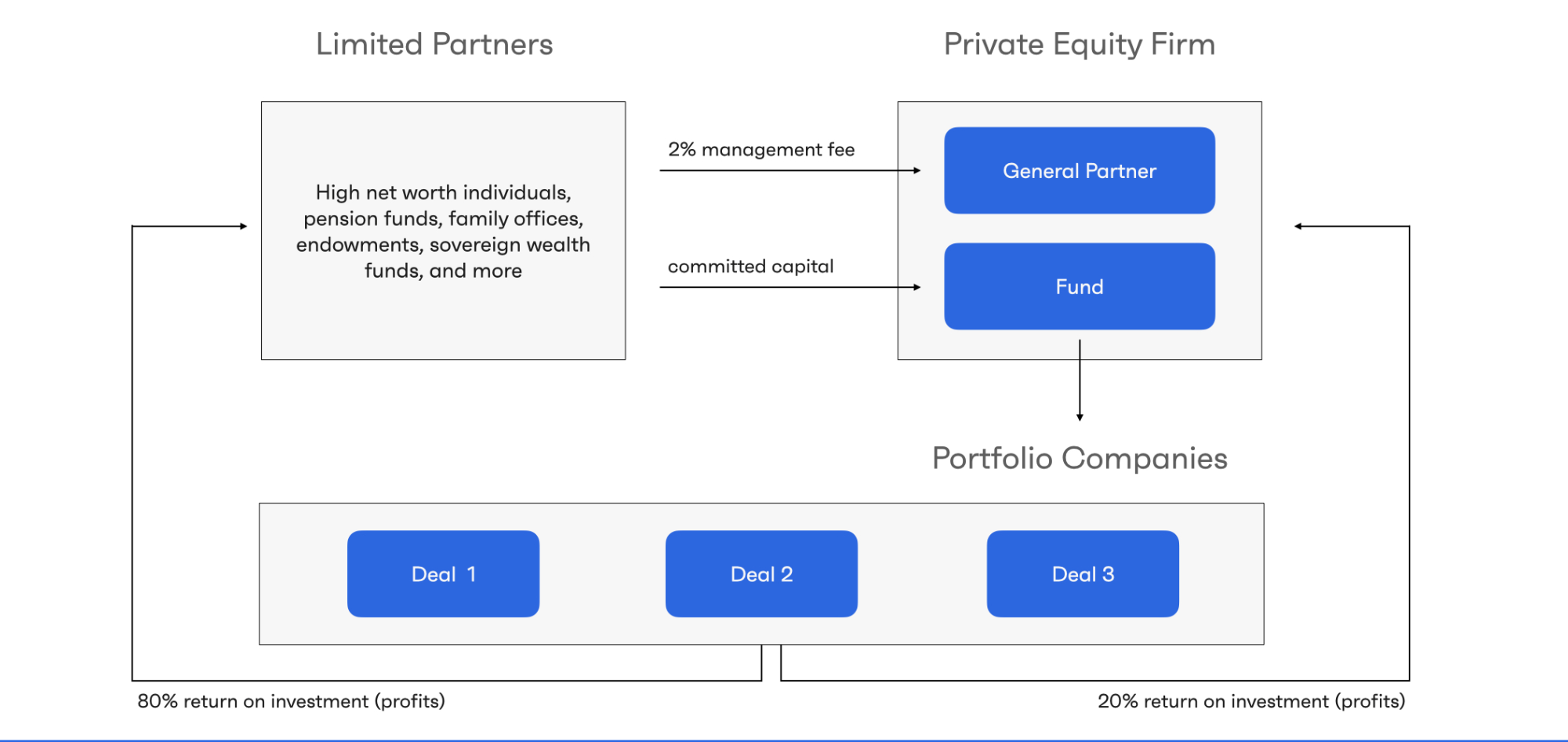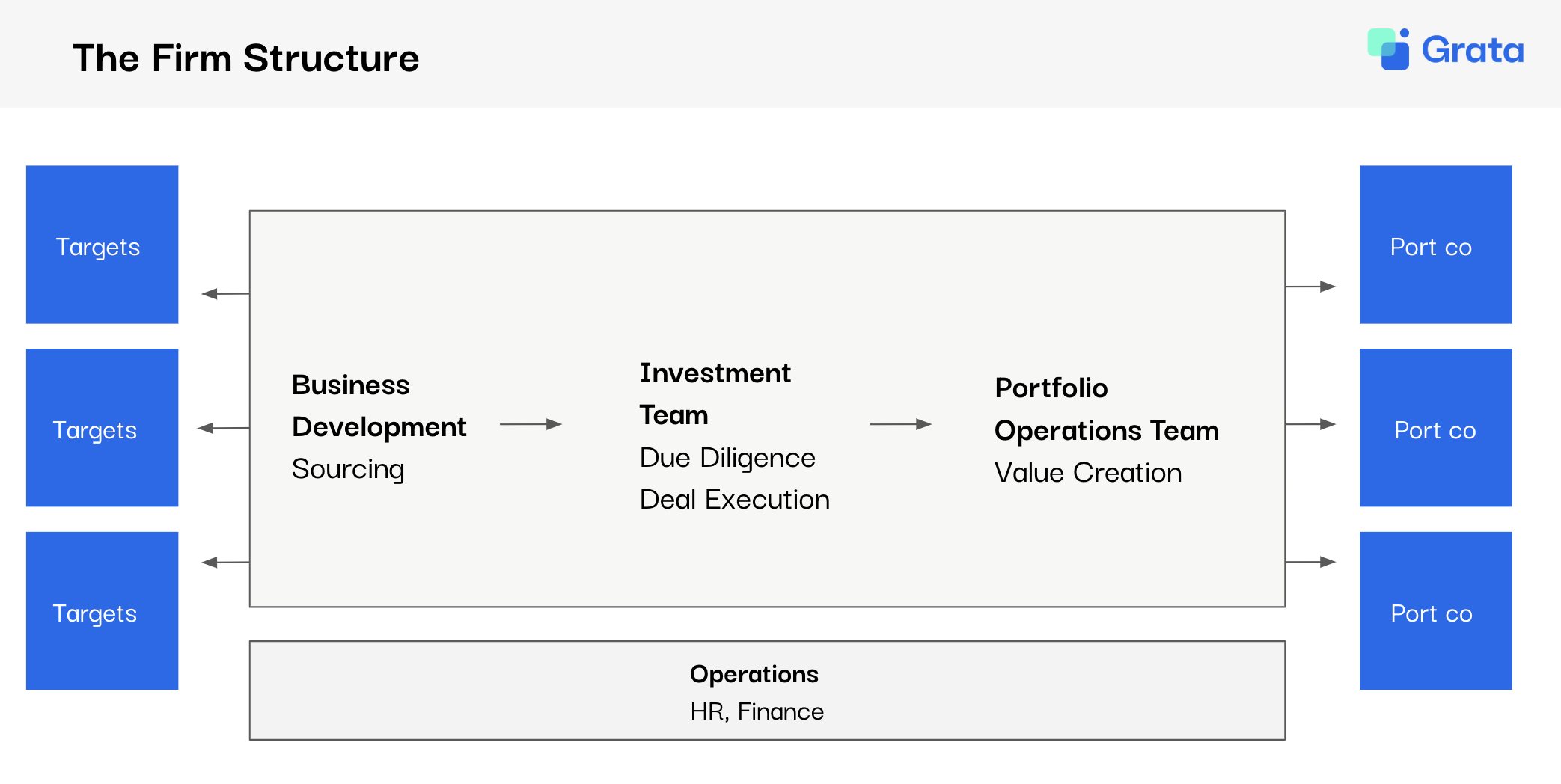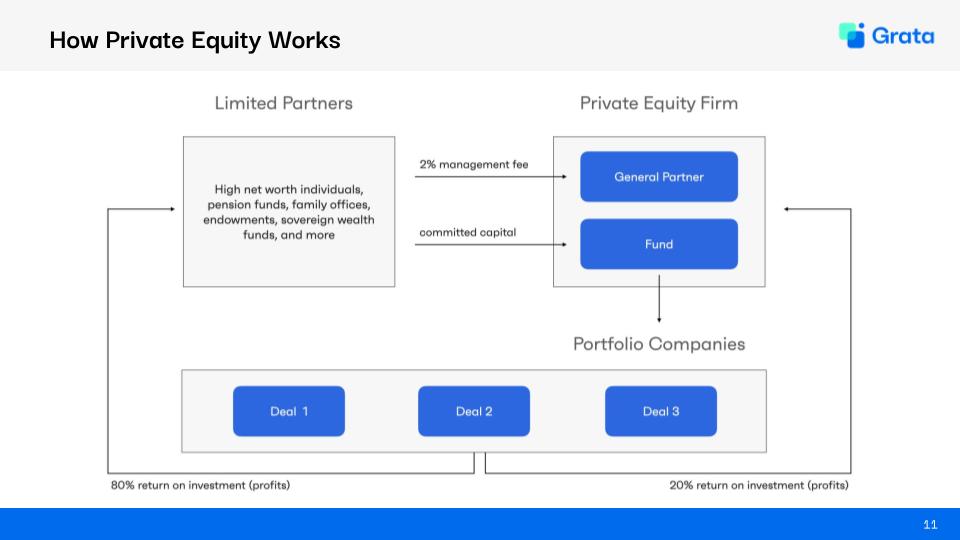Private equity is a fast-growing asset class, with the total private markets assets under management (AUM) reaching $11.7 trillion as of June 30, 2022.
The reason? Consistent, high returns.

But what exactly is a private equity firm, and how does it work? In this comprehensive guide, we will delve into the fundamentals of private equity fund structures.
What Is Private Equity?
At its core, private equity (PE) is a form of investment that involves acquiring ownership in private companies or taking public companies private. Unlike public equities, which are freely traded on stock exchanges, private equity investments are not publicly traded, offering a degree of exclusivity and control over the companies in which they invest.
PE Firm Structure
Investors in private equity typically enter into limited partnership agreements, becoming limited partners (LPs). This arrangement limits their liability while allowing them to participate in the fund's profits.
PE firms aim to achieve large returns for their LPs.
They do this by investing in companies with high-growth potential. The goal is to buy, nurture, and eventually sell these companies at a profit, delivering substantial returns.
What does this look like in action?
A typical PE fund will be, on average, 10 years in length. The PE firm will take a 2% management fee and typically a 20% performance fee when the asset is sold.

Private equity firms generate revenue through management fees and performance fees.
Management Fees
Management fees are charged as a percentage of the total assets under management (AUM) and cover the fund's operational expenses.
Performance Fees
Performance fees, also known as carried interest, are a share of the profits generated by the fund's investments. This incentivizes fund managers to deliver strong returns for investors.
PE Fund Sizes
Private equity funds vary significantly in size, with some managing billions of dollars in assets and others operating at a smaller scale. The size of a PE fund often reflects its investment strategy and target market. Larger funds typically focus on high-value transactions, while smaller funds may concentrate on niche opportunities.
The private equity investment process can be divided into four phases:
Phase 1: Fundraising
During this stage, private equity firms raise capital from investors, build a diverse investor base, and establish the fund's investment strategy.
Phase 2: Sourcing
Private equity professionals identify potential investment opportunities, conduct due diligence, negotiate deals, and make investments on behalf of the fund.
Phase 3: Managing
After making investments, private equity firms actively work to enhance the performance of portfolio companies by providing strategic guidance, operational improvements, and access to their network of resources.
Phase 4: Exiting
Exiting investments is a critical phase where private equity firms aim to realize profits for their investors. This can be achieved through various strategies, including follow-on investments, term extensions, and successful exit strategies like,
- Initial Public Offering (IPO)
- Trade Sale (Acquisition by Another Company)
- Secondary Sale to Another PE Firm
- Recapitalization
The Four Job Functions in PE

Successful private equity funds rely on a well-structured team to identify, execute, and manage investments. Four key job functions within a PE fund include Business Development, Investment Team, Portfolio Operations, and Operations.
Business Development Teams
BD teams are responsible for sourcing deals. They find companies that best fit the firm’s investment mandate and are ready to sell. BD Analysts conduct cold outreach and sell why an executive should discuss opportunities with their PE firm.
Investment Teams
Once a deal has been identified, the investment team steps in to conduct due diligence and finalize the deal.
Due diligence is a time-consuming and crucial part of the deal. It ensures the target is the best fit for the fund and uncovers any vulnerabilities that could jeopardize returns. There are 6 types of due diligence:
- Financial
- Operational
- Commercial
- Legal
- IT
- Environmental
Portfolio Operations
This team works directly with the executive teams from each of the firm’s portfolio companies (port cos). How involved the portfolio operations team is in the day-to-day company operations will vary depending on the firm. Some will be hands on, while others will give more responsibility and freedom to their port cos' executive teams.
Operations
Back-office operations include HR and Finance. These team members make sure the firm is compliant within a changing investing landscape.
PBD (Proactive Business Development)
As PE becomes a more competitive asset class, firms are looking for ways to differentiate themselves both to their LPs in fundraising and to company executives who now have more options when it comes to selling their business.
PBD is one way top firms are standing out.
PBD is a multi-channel deal sourcing strategy implemented by top PE and corporate M&A teams. It’s a holistic view of private marketing investing, specifically focused on network expansion through six channels.
- Bankers and Brokers
- Lawyers
- Accountants and Financial Advisors
- Investors
- Events and Conferences
- Executives
Unlocking the Middle Market for PE Firms
For PE firms investing in the middle market, private company data is hard to come by. Successful PBD relies on a deal sourcing platform to find targets and build relationships that close deals. Set up a demo to learn more.











